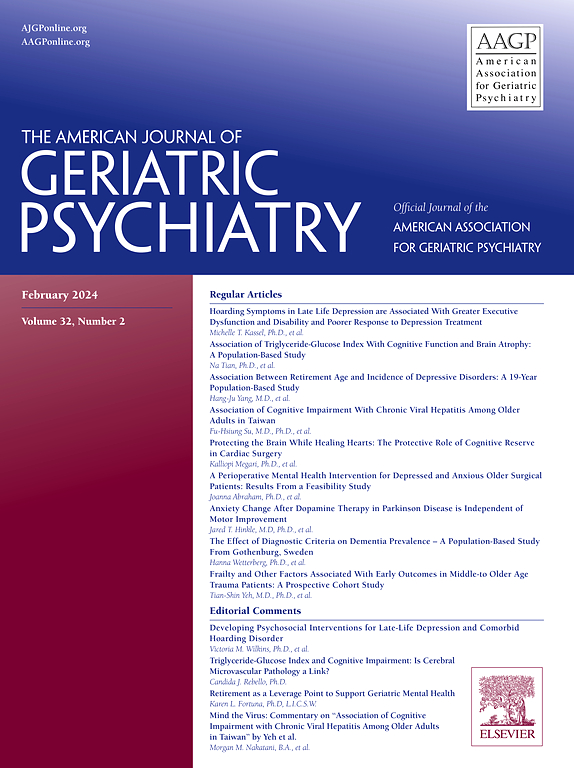101. EFFECTS OF PSYCHIATRIC DIAGNOSIS ON MEDICAL DIRECTIVE USAGE IN OLDER ADULTS: A LARGE DATASET EMR ANALYSIS AT A SAFETY-NET METROPLEX HOSPITAL
IF 3.8
2区 医学
Q1 GERIATRICS & GERONTOLOGY
引用次数: 0
Abstract
Introduction
Background: It is estimated that only 1/3rd of US adults will detail an Advance Directive in their lifetime. Advance directive completion is associated with a decreased risk of hospitalization, higher concordance between the individual’s end-of-life wishes with the provided care, and amelioration of the caregiver’s stress (Sedini et al., 2022). However, little is known about the intersection of psychiatric diagnoses, including neurocognitive disorders, on MAD usage. Thus, the goal of this study is to establish a robust framework on MAD usage through a novel EMR analysis of a large metroplex city population and elucidate how the adoption of MADs is influenced by psychiatric diagnoses.
Methods
Methods: A retrospective analysis of electronic record encounters for all adults (age > = 18 years) with a 2022 inpatient admission (n = 41,421) at Parkland Memorial hospital was conducted. To identify the presence of an Advance Directive, these records were queried for attachments with MAD-related titles. MAD adoption rates among patients with and without psychiatric diagnoses were compared.
Results
Results: 41,421 patients were included in the study (age= 43.75 ± 17.53 years, mean ± SD) from which 15,143 patients identified as male, and 26,278 patients identified as female. Across all patients, the adoption of medical advance directives was 8.75%. Among those who had a psychiatric diagnosis, 14.0% of patients utilized a form of advance directive while, among those who did not have a psychiatric diagnosis, only 6.1% had an advance directive (p < 0.001). Compared to the population without a psychiatric diagnosis, those that had diagnoses related to neurocognitive disorders had a 25.7% higher use rate of advance directives (p < 0.001). Similarly, comparing patients from other psychiatric disorder groups to the general population, the Anxiety/Depression, Substance Use Disorder, and Schizophrenia/Bipolar, had a 17.6%, 11.7%, and 10.5% increase in MAD usage, respectively (p < 0.001 for all three comparisons).
Conclusions
Conclusion: Despite known healthcare disparities for patients with psychiatric disorders, our results indicated that MAD usage is greater amongst those who have a psychiatric diagnosis compared to patients who do not. In particular, patients with neurocognitive disorders had higher rates of MAD usage, especially in comparison to patients with other psychiatric diagnoses. Further studies will investigate the potential confounding effects of age, race, and gender on MAD usage in patients with psychiatric comorbidities. Particularly given the health disparities faced by patients with neurocognitive disorders and other psychiatric diagnoses, medical centers must create systems-level interventions to promote inclusive and empowering MAD usage amongst older adults.
101. 精神病诊断对老年人医疗指示使用的影响:一个安全网大都市医院的大数据集emr分析
背景:据估计,只有1/3的美国成年人在其一生中会详细说明预嘱。预先指示的完成与住院风险降低、个人临终愿望与所提供的护理之间的更高一致性以及护理者压力的改善相关(Sedini et al., 2022)。然而,人们对包括神经认知障碍在内的精神病学诊断与MAD使用的交集知之甚少。因此,本研究的目的是通过对大型大都市人口的新颖EMR分析,建立一个关于MAD使用的稳健框架,并阐明精神病诊断如何影响MADs的采用。方法:回顾性分析帕克兰纪念医院2022年住院(n = 41,421)的所有成年人(年龄>; = 18岁)的电子病历。为了确定预先指示的存在,我们查询了这些记录中与mad相关标题的附件。比较有和没有精神病诊断的患者的MAD采用率。结果:共纳入41421例患者(年龄43.75±17.53岁,平均±SD),其中男性15143例,女性26278例。在所有患者中,采用医疗预先指示的比例为8.75%。在有精神病诊断的患者中,14.0%的患者使用了某种形式的预先指示,而在没有精神病诊断的患者中,只有6.1%的患者使用了预先指示(p <;0.001)。与没有精神病学诊断的人群相比,那些诊断为神经认知障碍的患者的预先指示使用率高出25.7% (p <;0.001)。同样,将其他精神障碍组的患者与一般人群进行比较,焦虑/抑郁、物质使用障碍和精神分裂症/双相情感障碍患者的MAD使用分别增加了17.6%、11.7%和10.5% (p <;三个比较均为0.001)。结论:尽管已知精神疾病患者的医疗保健存在差异,但我们的研究结果表明,与未被诊断为精神疾病的患者相比,被诊断为精神疾病的患者使用MAD的比例更高。特别是,神经认知障碍患者的MAD使用率更高,特别是与其他精神病诊断的患者相比。进一步的研究将调查年龄、种族和性别对精神合并症患者使用MAD的潜在混杂效应。特别是考虑到患有神经认知障碍和其他精神疾病的患者所面临的健康差异,医疗中心必须创建系统级干预措施,以促进老年人对MAD的包容和授权使用。
本文章由计算机程序翻译,如有差异,请以英文原文为准。
求助全文
约1分钟内获得全文
求助全文
来源期刊
CiteScore
13.00
自引率
4.20%
发文量
381
审稿时长
26 days
期刊介绍:
The American Journal of Geriatric Psychiatry is the leading source of information in the rapidly evolving field of geriatric psychiatry. This esteemed journal features peer-reviewed articles covering topics such as the diagnosis and classification of psychiatric disorders in older adults, epidemiological and biological correlates of mental health in the elderly, and psychopharmacology and other somatic treatments. Published twelve times a year, the journal serves as an authoritative resource for professionals in the field.

 求助内容:
求助内容: 应助结果提醒方式:
应助结果提醒方式:


